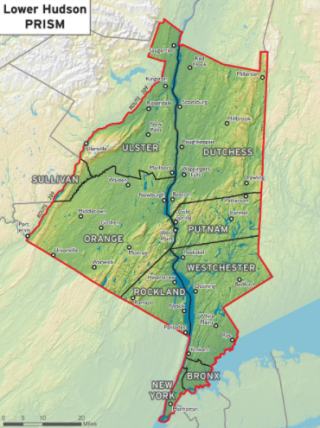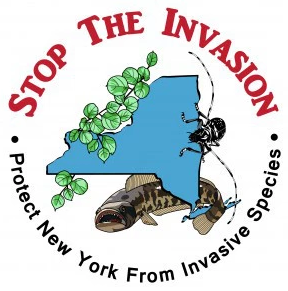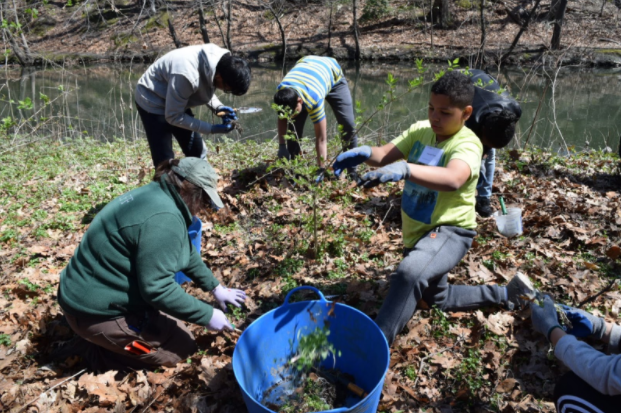In Search of Invasive Plant Species in the Lower Hudson Region
Posted in Environment on August 10, 2017 by Jessica Arcate Schuler
Jessica Arcate-Schuler is NYBG‘s Director of the Thain Family Forest.

Since 2013, NYBG has partnered with the Lower Hudson Partnership for Regional Invasive Species Management (LHPRISM) to identify, monitor, manage, and educate about invasive species in our region, which includes Manhattan, Bronx, Westchester, Putnam, Dutchess, Rockland and the eastern parts of Sullivan and Ulster Counties (map image credit: http://lhprism.org/)
An invasive species is defined as a species that is non-native to the ecosystem under consideration and causes or is likely to cause economic or environmental harm or harm to human health. Did you know that there are 146 invasive plant species that threaten the Lower Hudson Region’s ecosystems?
This season, NYBG hosted a citizen science training for the LHPRISM 2017 BlockBuster Survey that taught volunteers how to identify and monitor for 27 of the terrestrial plant species that have limited data in New York’s online mapping program called iMapInvasives and are regional candidates for eradication and containment. In one day, 22 volunteers learned how to identify each plant species, how to sample following the survey protocol, and use an app to collect the data. What makes this survey effort unique, is the extensive regional searching for presence and absence of each of the 27 terrestrial plant species. Each volunteer or team was assigned a three-mile by three-mile grid in which they have until mid September to search for the invasive species of interest.
The data they collect will be analyzed by LHPRISM partners, Ecological Research Institute, and entered into iMapInvasives. Ultimately, this project will help determine the presence and abundance of each of the 27 species throughout the region, help LHPRISM establish Invasive Species Prevention Zones (ISPZs, or natural areas with high native biodiversity and low invasive species abundance that will be high priorities for monitoring and management), and assist in the prioritization for regional management and ecological restoration.
Invasive Species Awareness Week
NYBG has modified the LHPRISM BlockBuster Survey training materials into high school curriculum as part of GEAR-UP (Gaining Early Awareness and Readiness for Undergraduate Programs) a program of the Bronx Institute at Lehman College that partners with NYBG for education programs involving plants. The new invasive species curriculum trains students in the basics of plant identification, field sampling techniques, conservation issues, citizen science, and hands-on management experience. The goal of GEAR-UP is to expose high school students to new fields as they start their undergraduate college search and to provide support throughout high school to increase graduation rates. All of the data collected by the GEAR-UP students at NYBG are entered into iMapInvasives and contribute to the representation of invasive species abundance and distribution locally, and help provide a better picture across the state. The response from the students has been tremendous from plant identification to exploring outside. After spending part of the afternoon weeding with the Forest staff, they became slightly overwhelmed by how abundant invasive plants are and the amount of time and effort that is required to manage them correctly.
 Through our work in the Thain Family Forest, we are well aware of the overwhelming challenges in managing invasive species, but there are many things we can all do to participate in the prevention and management of invasive species that preserves the integrity of our local ecosystems.
Through our work in the Thain Family Forest, we are well aware of the overwhelming challenges in managing invasive species, but there are many things we can all do to participate in the prevention and management of invasive species that preserves the integrity of our local ecosystems.
- Spread the word! Share this post or teach others about invasive species in our region. We recently finished NYS Invasive Species Awareness Week—consider participating next year and learn more.
- Participate in a local event! Find out about what’s happening with your local PRISM, or local park or natural area.
- Don’t plant invasive plants in your garden! Consider replacing them with native alternatives. Use this list of 146 species of concern in the Lower Hudson Region as a reference, check out online resources from The Connecticut Agricultural Experiment Station and Cornell University, or contact me for alternatives advice. Manage invasive species on your property using Best Management Practices for Priority Invasive Plants in the Hudson Valley Region.
- Stop the spread! Always clean your shoes and clothes when hiking in different natural areas. Your furry hiking companion should also be brushed.
- See something? Say something! Report invasive species by taking a picture with location information and submitting it to iMapInvasives or emailing your local PRISM coordinator.
- Learn more! Save the date and join LHPRISM and NYBG on November 3, 2017, for “Invasive Species Summit: Restoration and Long-term Management.” Register here.


